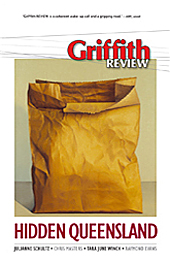Featured in

Buy
$19.95
- Published 20080902
- ISBN: 9780733322839
- Extent: 296 pp
- Paperback (234 x 153mm)

Already a subscriber? Sign in here
If you are an educator or student wishing to access content for study purposes please contact us at griffithreview@griffith.edu.au
Share article
About the author

Paul Turnbull
Paul Turnbull is a historian and professor in the School of Humanities, Griffith University.
More from this edition

Scratch the Surface – Flower power
ReportageThe first sight from the air is a glint in the distance, a hill, an impression of water, a scattering of buildings. Then the...

My Queensland – Training in resolve
ReportageThe first forty-six years of my life were spent in Ipswich and Brisbane; the territory has imprinted itself at the deepest level of my...

The Olden Days – Toowoomba
ReportageThe huge cop – they all seemed to be huge in Queensland in 1976 – rustled through my desk drawer as if I wasn't...
Stay up to date with the latest, news, articles and special offers from Griffith Review.